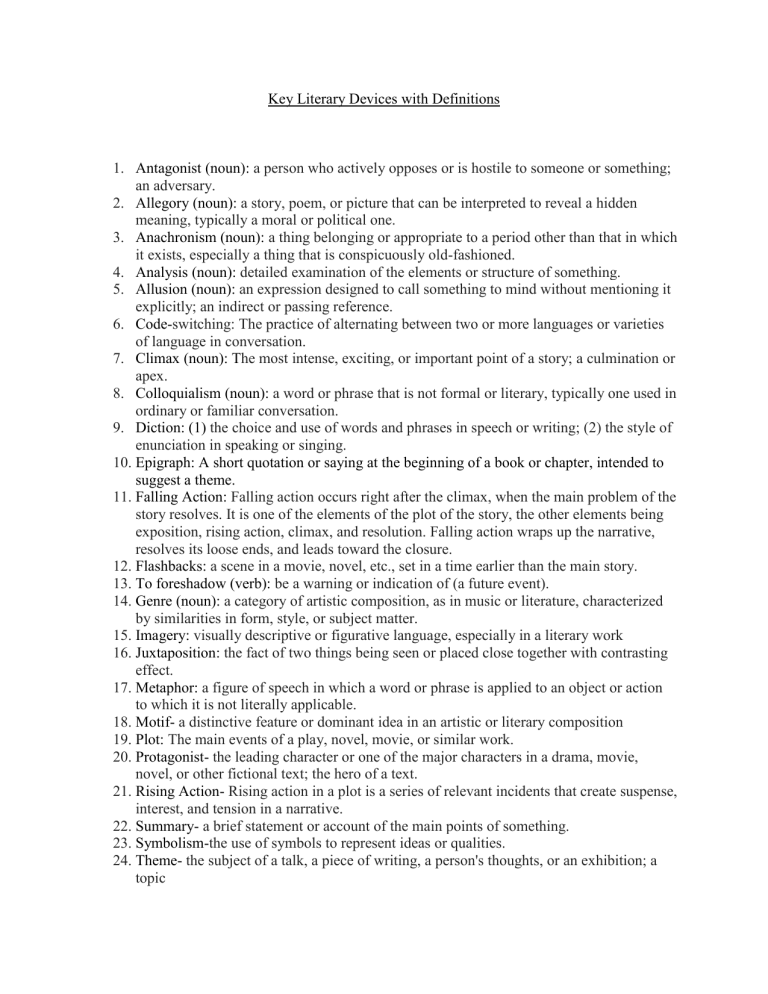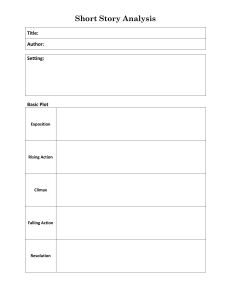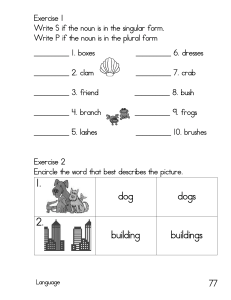
Key Literary Devices with Definitions 1. Antagonist (noun): a person who actively opposes or is hostile to someone or something; an adversary. 2. Allegory (noun): a story, poem, or picture that can be interpreted to reveal a hidden meaning, typically a moral or political one. 3. Anachronism (noun): a thing belonging or appropriate to a period other than that in which it exists, especially a thing that is conspicuously old-fashioned. 4. Analysis (noun): detailed examination of the elements or structure of something. 5. Allusion (noun): an expression designed to call something to mind without mentioning it explicitly; an indirect or passing reference. 6. Code-switching: The practice of alternating between two or more languages or varieties of language in conversation. 7. Climax (noun): The most intense, exciting, or important point of a story; a culmination or apex. 8. Colloquialism (noun): a word or phrase that is not formal or literary, typically one used in ordinary or familiar conversation. 9. Diction: (1) the choice and use of words and phrases in speech or writing; (2) the style of enunciation in speaking or singing. 10. Epigraph: A short quotation or saying at the beginning of a book or chapter, intended to suggest a theme. 11. Falling Action: Falling action occurs right after the climax, when the main problem of the story resolves. It is one of the elements of the plot of the story, the other elements being exposition, rising action, climax, and resolution. Falling action wraps up the narrative, resolves its loose ends, and leads toward the closure. 12. Flashbacks: a scene in a movie, novel, etc., set in a time earlier than the main story. 13. To foreshadow (verb): be a warning or indication of (a future event). 14. Genre (noun): a category of artistic composition, as in music or literature, characterized by similarities in form, style, or subject matter. 15. Imagery: visually descriptive or figurative language, especially in a literary work 16. Juxtaposition: the fact of two things being seen or placed close together with contrasting effect. 17. Metaphor: a figure of speech in which a word or phrase is applied to an object or action to which it is not literally applicable. 18. Motif- a distinctive feature or dominant idea in an artistic or literary composition 19. Plot: The main events of a play, novel, movie, or similar work. 20. Protagonist- the leading character or one of the major characters in a drama, movie, novel, or other fictional text; the hero of a text. 21. Rising Action- Rising action in a plot is a series of relevant incidents that create suspense, interest, and tension in a narrative. 22. Summary- a brief statement or account of the main points of something. 23. Symbolism-the use of symbols to represent ideas or qualities. 24. Theme- the subject of a talk, a piece of writing, a person's thoughts, or an exhibition; a topic 25. Tone-the general character or attitude of a place, piece of writing, situation, etc. The emotional voice an author gives to a piece.







